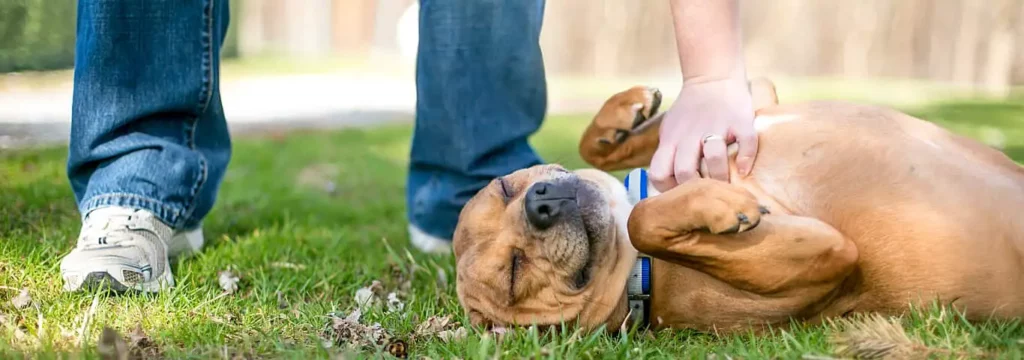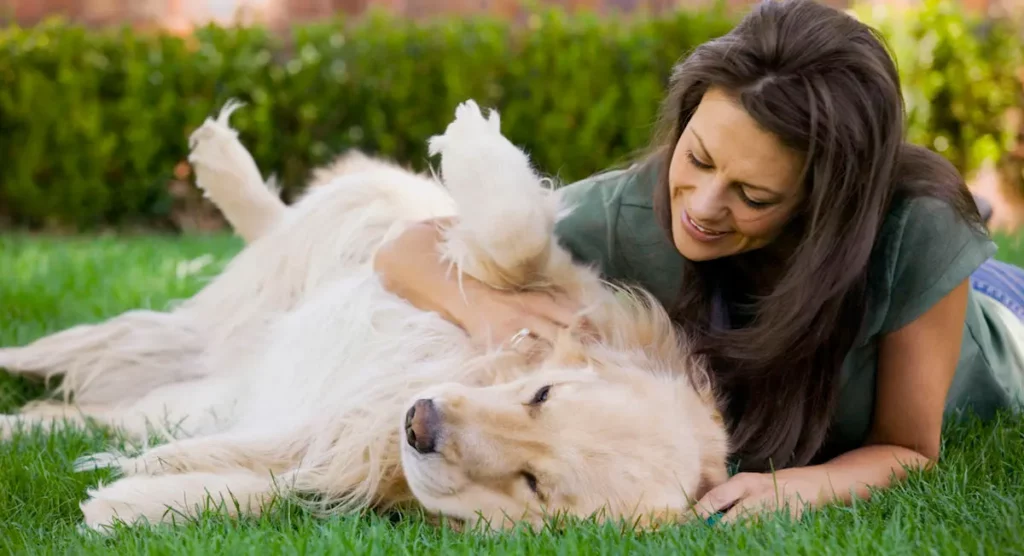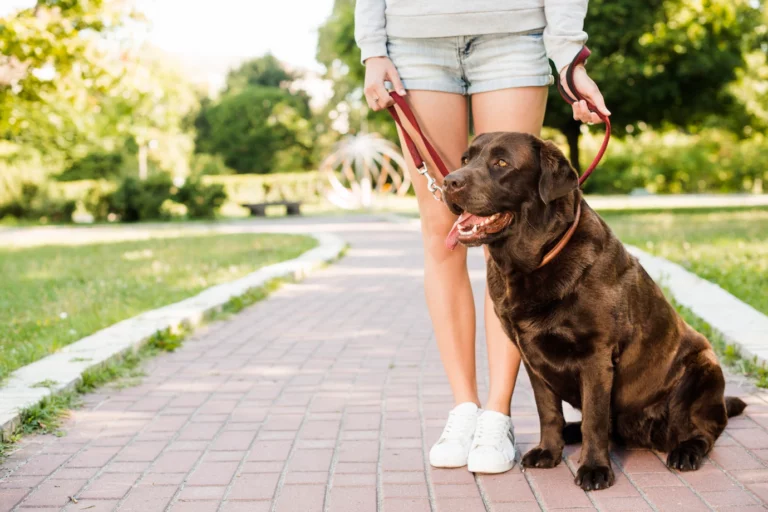Why Do Dogs Love Belly Rubs? The Science Behind It
Have you ever noticed that when you approach your dog, they instantly flop onto their back, inviting you to give them a belly rub? This adorable behavior seems to be a universal trait among dogs, as they enthusiastically wiggle and squirm while you shower them with affection.
It’s clear that our canine companions have a deep-seated love for a good belly rub, but have you ever wondered why?
We’ll delve into the science behind why dogs adore belly rubs and how this simple act of love benefits both you and your furry friend. We’ll also explore the trust and vulnerability associated with this behavior, the social aspects of belly rubs, and the health benefits they can offer.
Plus, we’ll share some tips on how to give your dog the perfect belly rub, ensuring a happy, relaxed pup every time. So, let’s dive in and uncover the secrets behind one of dogs’ favorite pastimes!
Key takeaways
Belly rubs are a form of social bonding and affection for dogs, similar to grooming behavior in wild dog packs.
It releases endorphins in dogs, providing a sense of comfort and relaxation.
Exposing the belly is also a sign of trust and submission from a dog.
Not all dogs enjoy belly rubs; individual preferences can vary.
Always approach a dog gently and calmly, especially when attempting to touch their belly for the first time.
If a dog shows signs of discomfort or aggression, stop the belly rub immediately.
The Science of Belly Rubs
1. The role of nerve endings and touch receptors
Abdominal region sensitivity
The first reason dogs love belly rubs is due to the sensitivity of their abdominal region. The skin on a dog’s belly has a high concentration of nerve endings and touch receptors, making it particularly responsive to touch. When you rub their belly, it stimulates these nerve endings, creating a pleasurable sensation for your dog.
Sensation of pleasure
Dogs are also known to have specific touch receptors called Pacinian corpuscles, which are responsible for detecting sensations like pressure and vibration. These receptors are most abundant in areas like the belly, making it even more sensitive to touch.
When you stroke your dog’s belly, these receptors send signals to their brain, which releases feel-good chemicals like endorphins, contributing to a delightful, soothing experience for your pup.
2. Release of oxytocin
The love hormone
Another reason dogs enjoy belly rubs is the release of oxytocin, often referred to as the “love hormone.” Oxytocin plays a significant role in social bonding and attachment, not only in dogs but also in humans.
When you and your dog engage in physical touch, such as during a belly rub, both of your oxytocin levels increase, leading to a sense of connection and attachment.
Bonding with their humans
Belly rubs provide an opportunity for you and your dog to bond, as they reinforce trust and affection between the two of you. This release of oxytocin strengthens the human-dog bond, making your dog feel more secure and loved.
It also creates a positive feedback loop, as the more you engage in belly rubs, the more your dog will associate this activity with happiness and love, making them more likely to seek out belly rubs in the future.

Trust and Vulnerability
1. Exposing their belly as a sign of trust
Natural instincts and submission
When a dog exposes their belly, it’s not just an invitation for a belly rub—it’s also a sign of trust and vulnerability. In the wild, a dog’s belly is one of their most sensitive and unprotected areas. By willingly exposing their belly to you, your dog is demonstrating their trust in you and showing that they feel safe in your presence.
Strengthening the human-dog bond
This trust and vulnerability are essential components of the human-dog bond. By giving your dog belly rubs, you’re reinforcing their trust in you, which can lead to a more secure, well-adjusted, and happy dog. This deepens your connection and fosters a stronger bond between you and your furry companion.
2. The importance of respecting a dog’s boundaries
Reading body language
While many dogs enjoy belly rubs, it’s crucial to recognize and respect your dog’s boundaries. Some dogs may not feel comfortable exposing their belly, or they may become nervous or tense during a belly rub.
It’s essential to read your dog’s body language and understand their preferences to ensure you’re providing a positive experience for them.
Knowing when to stop
If your dog appears uncomfortable or tries to move away during a belly rub, it’s essential to stop immediately. Forcing a belly rub on a dog that doesn’t enjoy it can lead to increased anxiety and stress, ultimately damaging the bond you share.
Always respect your dog’s boundaries and adjust your interactions based on their comfort level and preferences.

Belly Rubs as Social Interaction
1. Mimicking grooming behavior
Social grooming in the wild
Belly rubs also serve as a form of social interaction between you and your dog, as they mimic the grooming behavior commonly seen among dogs in the wild. In their natural environment, dogs engage in social grooming to maintain cleanliness, strengthen social bonds, and establish hierarchy within their group.
When you give your dog a belly rub, you’re participating in a similar social ritual that promotes bonding and connection.
Strengthening social bonds
By engaging in belly rubs with your dog, you’re reinforcing your role as a trusted, caring member of their “pack.” This not only strengthens the bond between you and your dog, but it also contributes to their overall sense of security and well-being.
2. Positive reinforcement and training
Rewarding good behavior
Belly rubs can also be used as a form of positive reinforcement during training. By offering belly rubs as a reward for good behavior, you’re encouraging your dog to associate that behavior with positive outcomes, making it more likely they’ll repeat it in the future.
This can be particularly helpful for encouraging calm and relaxed behavior in dogs that may be prone to anxiety or excitability.
Encouraging calmness and relaxation
In addition to reinforcing good behavior, belly rubs can also promote calmness and relaxation in your dog. The soothing sensation of a belly rub can help reduce anxiety and stress, making it an excellent tool for helping your dog unwind after a busy day or as a calming activity during times of heightened stress or excitement.
What is my dog thinking?
Exposing their belly for a rub indicates your dog feels comfortable and trusts you. The act of belly rubbing releases feel-good hormones in dogs, making it a pleasurable experience.
Health Benefits of Belly Rubs
Improving circulation and muscle relaxation
One of the key health benefits of belly rubs is that they can help improve your dog’s circulation. The gentle pressure and stroking motions of a belly rub stimulate blood flow in your dog’s body, particularly in the abdominal area.
This increased circulation can help promote healing, reduce inflammation, and improve overall health.
Additionally, belly rubs can help relax your dog’s muscles. The soothing touch and gentle pressure can help release tension and tightness in their abdominal muscles, promoting relaxation and comfort.
Reducing stress and anxiety
As mentioned earlier, belly rubs can help reduce stress and anxiety in your dog. The pleasurable sensation and release of feel-good chemicals like endorphins and oxytocin can create a calming effect, helping your dog feel more relaxed and at ease.
Early detection of potential health issues
1. Checking for lumps, bumps, and injuries
Regular belly rubs also provide an opportunity for you to check your dog for any potential health issues. As you rub their belly, you can gently feel for any lumps, bumps, or injuries that may require veterinary attention. Early detection of these issues can be crucial for your dog’s health and well-being.
2. Monitoring for changes in skin and fur
In addition to checking for lumps and bumps, belly rubs also allow you to monitor your dog’s skin and fur health. During the belly rub, you can check for any changes in your dog’s skin, such as redness, dryness, or irritation, as well as any abnormalities in their fur, like excessive shedding or matting.
By keeping an eye on your dog’s skin and fur health, you can address any issues early on and help maintain their overall well-being.
Tips for the Perfect Belly Rub
Finding the sweet spot
Each dog has their own unique preferences when it comes to belly rubs, so it’s essential to pay attention to your dog’s reactions and find the “sweet spot” that they enjoy the most. Some dogs may prefer gentle strokes near their chest, while others might enjoy a good scratch near their hind legs.
By observing your dog’s responses, you can tailor your belly rubs to their specific preferences, ensuring a pleasurable experience every time.
Using gentle and varied strokes
To give your dog the perfect belly rub, use gentle and varied strokes. Start with light pressure and gradually increase it based on your dog’s reactions. You can experiment with different types of strokes, such as long, sweeping motions or circular rubs, to see what your dog enjoys the most.
Remember that each dog is different, so what works for one dog may not work for another.
Recognizing and respecting your dog’s preferences
As you give your dog belly rubs, be sure to recognize and respect their preferences. If your dog seems uncomfortable or tries to move away, stop the belly rub and give them some space.
On the other hand, if your dog appears to be enjoying the experience, continue to provide the belly rub and use their reactions as a guide for how to adjust your technique. By respecting your dog’s boundaries and preferences, you can ensure that belly rubs are a positive, enjoyable experience for both of you.
Frequently Asked Questions
Are belly rubs safe for all dogs?
Belly rubs are generally safe for most dogs, as long as you’re gentle and attentive to their reactions. However, some dogs may have medical conditions, injuries, or sensitivities that make belly rubs uncomfortable or painful.
Always pay attention to your dog’s body language and preferences, and consult your veterinarian if you have any concerns about your dog’s health or comfort.
What should I do if my dog doesn’t like belly rubs?
If your dog doesn’t enjoy belly rubs, it’s essential to respect their preferences and boundaries. Instead, try offering other forms of affection or praise, such as petting their head, back, or chest, or using verbal praise and treats as rewards.
Each dog is unique, so it’s important to find the type of affection that works best for your individual dog.
Can belly rubs be used as a training tool?
Yes, belly rubs can be used as a form of positive reinforcement during training. By offering belly rubs as a reward for good behavior, you can encourage your dog to associate that behavior with positive outcomes.
This can be particularly helpful for promoting calm and relaxed behavior in dogs that may be prone to anxiety or excitability.
How can I tell if I’m rubbing my dog’s belly too hard?
To determine if you’re rubbing your dog’s belly too hard, pay close attention to their body language and reactions. If your dog appears uncomfortable, tense, or tries to move away during the belly rub, it’s a sign that you may be applying too much pressure.
Adjust your technique by using lighter, gentler strokes, and observe your dog’s response to ensure they’re comfortable and enjoying the experience.
Is it normal for my dog to kick their legs during a belly rub?
Yes, it’s normal for some dogs to kick their legs during a belly rub. This involuntary reaction, known as the “scratch reflex,” is caused by the stimulation of nerves in the belly area. It’s usually a harmless and natural response, but if your dog appears distressed or uncomfortable while kicking, it’s best to stop the belly rub and try a different form of affection.
How often should I give my dog a belly rub?
There’s no set rule for how often you should give your dog a belly rub, as each dog has their own preferences and tolerance for physical touch. The key is to pay attention to your dog’s body language and reactions and offer belly rubs when they seem receptive and comfortable.
Some dogs may enjoy daily belly rubs, while others may prefer them less frequently.
Can I give my dog a belly rub if they are pregnant or have recently given birth?
It’s best to exercise caution when giving a pregnant or recently postpartum dog a belly rub. Their abdominal area may be sensitive or tender, and applying pressure could cause discomfort or harm.
Always consult your veterinarian for guidance on how to safely interact with your pregnant or postpartum dog, and consider offering alternative forms of affection that don’t involve the abdominal area.
Final Thoughts
Now that we’ve uncovered the secrets behind dogs’ love for belly rubs, it’s easy to see why this simple act of affection is so universally adored by our canine companions.
From the science of nerve endings and oxytocin release to the trust and vulnerability displayed by your dog, belly rubs offer numerous benefits for both you and your furry friend.
By embracing the joy of belly rubs, you can strengthen the bond you share with your dog, promote their overall well-being, and participate in a cherished ritual that has deep roots in canine social behavior.
As you continue to give your dog belly rubs, remember to respect their boundaries, observe their preferences, and always approach this interaction with love and care. In doing so, you’ll ensure that belly rubs remain a positive, enjoyable experience that enhances the special connection between humans and dogs.






![Poisoning in Dogs Symptoms [5 Signs Your Dog Has Poisoning]](https://www.warmlypet.com/wp-content/uploads/2022/12/poisoning-in-dogs-symptoms-768x512.webp)